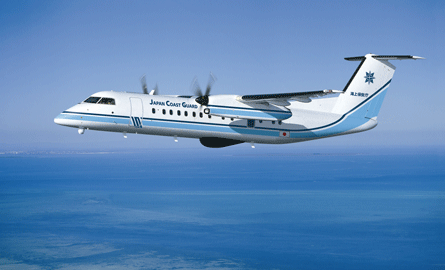Modifying commercial aircraft for paramilitary roles has long been a key strength of Canadian conversion company Field Aviation. But with a follow-on order for the conversion of additional Bombardier Q300s for the Japan Coast Guard's maritime surveillance missions, potential new business with the US Customs and Border Protection office, and an established global customer base that also includes Australia, Iceland and Sweden, 60-year old Field sees "a huge continuing business in this little niche to the point where I wouldn't say it's a little niche anymore", says director of sales David Jensen. "It's a very large niche now."
Although it has a long history of converting Bombardier aircraft, Field remains completely unaffiliated with any original equipment manufacturers, be they airframers or sensor systems makers. Finmeccanica's Alenia Aeronavali division, which modifies ATR aircraft, and EADS Casa, which configures its own aircraft for maritime patrol, pose the largest direct competition to Field, says Jensen.
Smaller platforms
But the Toronto firm is also seeing a lot of activity in some smaller platforms "as some of the world's smaller forces get involved in the security business -both with single and twin-engined turboprops, both pressurised and unpressurised". The company delivers fully civil-certified solutions whenever possible, giving governments the flexibility to transition the aircraft to the commercial fleet if desired.

To keep up with demand, Field - a wholly owned subsidiary of UK energy services company Hunting - has been operating at over 100% capacity at its Toronto Pearson modification centre for the last three-plus years. "We're selling ourselves full every year. Full production for us is something in the order of five to eight [modified] aircraft depending on configuration. We expect to continue that for the foreseeable future," says Jensen.
This will ensure that Field meets the Japan Coast Guard's new requirement for the conversion of an additional two Q300 maritime patrol (MPA)/search and rescue platforms for delivery in November 2009, following an initial contract last year for three Q300 MPA modifications, which are currently under completion and will be delivered by the end of this year.
Bombardier's sales representative in Japan, Sojitz of Tokyo, is the prime contractor to the Japan Coast Guard on the entire project. The turboprops will feature a missionised interior, large conformal observation windows and a Field-developed and certified air-drop capability through the inflight-operable rear cargo door. Surveillance sensors will be installed, including a 360˚ surface search radar, a stabilised FLIR electro-optical multi-spectral imaging payload, as well as a new suite of navigation communications systems. The Japan Coast Guard largely picked its own sensor fleet, the manufacturer of which has not been revealed. The modified Q300s will replace some retiring NAMC YS-11 turboprops at the Japan Coast Guard, although "it's not a one-for-one" swap, says Jensen.
The Dash 8 was first modified for maritime patrol role by Field in 1995, when three aircraft were delivered to Surveillance Australia, which provides airborne surveillance of the Australian Exclusive Economic Zone. Surveillance Australia just took delivery of its last aircraft from Field for a total of 10 - a mixture of converted Q200s and Q300s, of which two were acquired used and the rest were brand new from Bombardier.
Other customers for Field's Dash 8 MPA modifications include US Customs, which has accepted delivery of three modified Q200s through one-aircraft deals and is earmarked for a fourth. "There is an expectation of another programme for several [more aircraft] - those would be Q300s," reveals Jensen, noting that these would be the first Q300 MPA modifications from US Customs.
Field also has existing contracts with the Swedish Coast Guard and the Iceland Coast Guard. In total, Field has brokered deals for a total of 27 modified Dash 8s that are either on order, in the process of production or have been delivered. All but four or five of these modified aircraft are being delivered factory-new to Field.
Source: Flight International























